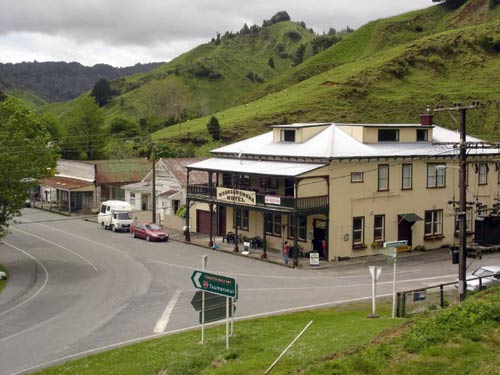
Jason Wright remembers a childhood trip to Whangamōmona, and seeing its 1911 hotel for the first time.
What\'s you story?
Contributed by Jason Wright
It was one of those classic spring days – clear blue sky, slight breeze and somewhere to go. Dad had driven my brother and me to stay with our grandparents in Eltham. We were happy there, with its peace and tranquillity, and the wide footpaths with their thick layer of fine gravel that served as our sandpit.
On this trip to Taranaki, Dad also planned on taking us to Whangamōmona – home of his forebear, James Wright, a one-time household guard to Queen Victoria. He’d owned some of the steep and rugged land that overlooked the town, but eventually sold it on and retired, having too many sons to split the land into reasonably sized blocks for each of them to farm.
The day Dad drove us there, I knew I had arrived somewhere significant. State Highway 43 snaked its way through hills studded with kahikatea and mānuka, growing steeper and more rugged the further in we went. Misty clouds hung among the trees of the higher slopes.
While the trip there is worthy of its own story, the town held me captivated. It still does.
The main feature is the hotel, dubbed the ‘Whanga’. Being too young, we never went into the pub on that first journey. In fact, my father was 65 by the time he finally made it into the bar; as a teenager, when he lived with his cousin in the town, he’d been disallowed from entering. On that day, we just stared through the windows.
Standing in the main street, across from the old McCluggage store, we heard the muted cheering of a local rugby match. This was immediately overshadowed by the sudden roaring of a bull, echoing through the valley. I felt anxious at the sound, unsure of where it was coming from, or whether we might find the animal on the loose somewhere close by. We also saw a mangled piece of corrugated iron sitting on the side of the road. It served as a shelter for a small goat that was butting against the tin. I crouched down and looked into the darkness and saw its eyes gleaming back. Dad gave a little laugh and steered us away, back past the pub, towards the rugby ground and the cemetery where his grandfather is buried.
Once at the graveyard, we leaned silently over the fence, hearing the small crowd of supporters in the neighbouring field, the bull still calling intermittently across the valley, punctuated by cackling magpies. The grass was almost covering some of the small headstones. We climbed over the fence and wandered among the markers and wet grass, soaking our trouser bottoms and shoes. In front of some of the older headstones, we searched for any fallen lead letters that we could put back into the stones. As we walked back to the car, the sun shining on one of those classic spring days, I remember thinking how I would definitely come back.
Te whakamahi i tēnei tūemi
Private collection
Photograph by Rachel Roberts
This item has been provided for private study purposes (such as school projects, family and local history research) and any published reproduction (print or electronic) may infringe copyright law. It is the responsibility of the user of any material to obtain clearance from the copyright holder.









Tāpiritia te tākupu hou